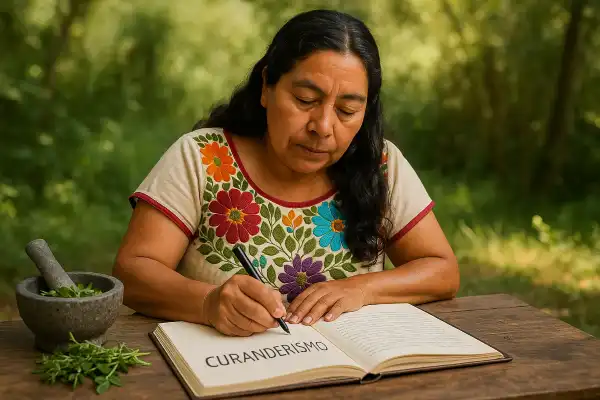Understanding curanderismo meaning in Spanish opens a window into centuries of ancestral wisdom that continues to nurture communities across Mexico and beyond. This sacred healing tradition carries within it the profound knowledge of our antepasados, woven through generations like threads in a rebozo.
María del Pilar Fernández, drawing from her lifelong immersion in curandera practices and her lineage of healers from Oaxaca, believes that comprehending the true essence of curanderismo requires more than translation—it demands understanding the cultural heart that beats within these ancient words and the healing spirit they embody.
Curanderismo meaning in Spanish
Curanderismo meaning in Spanish stems directly from the verb “curar,” which translates to “heal” or “cure.” The practice of curanderismo, therefore, literally means “the art of healing” or “the system of healing.”
The word itself carries layers of meaning that extend far beyond simple translation. In Spanish, “curar” encompasses not only physical healing but also spiritual restoration, emotional balance, and the mending of relationships within families and communities. When we add the suffix “-ismo” to create “curanderismo,” we’re describing an entire philosophical and practical approach to wellness that has evolved over five centuries.

The linguistic roots of healing
The Spanish term “curanderismo” combines “curar” (to heal) with the suffix “-ismo,” which denotes a system, practice, or doctrine. This linguistic construction reveals the comprehensive nature of this healing tradition. Unlike conventional medicine that focuses primarily on symptoms, curanderismo addresses the whole person—body, mind, spirit, and social connections.
In Mexico, curanderismo is also known by several other Spanish terms that illuminate different aspects of the practice. “Medicina del campo” translates to “medicine of the countryside,” emphasizing its rural, earth-based origins. “Medicina tradicional mexicana” means “Mexican traditional medicine,” placing it within the broader context of indigenous healing systems that predate Spanish colonization.
Cultural significance beyond translation
The meaning of curanderismo in Spanish cannot be separated from its cultural context. The word “curandera” (female healer) incorporates the qualities expected of a “cura”—a priest or minister—suggesting the sacred, confidential nature of the healing relationship. This linguistic connection reveals how curanderismo bridges the spiritual and physical realms, treating illness as a disruption in the harmony between body, spirit, and environment.
Regional variations in Spanish-speaking countries have given birth to related terms. In some areas, practitioners might be called “sobadoras” (those who massage and manipulate), “yerberas” (herbalists), or “parteras” (midwives), each representing specialized aspects of the broader curanderismo tradition. These terms reflect the diverse ways healing knowledge manifests across different communities.
Historical evolution of the term
The Spanish colonization of the Americas in the 16th century created the conditions for curanderismo as we know it today. Indigenous healing practices that had existed for millennia—including Aztec, Maya, and other Mesoamerican traditions—merged with Spanish Catholic rituals and, in some regions, African healing practices brought by enslaved people.
This synthesis created a unique healing system that retained indigenous plant knowledge while incorporating Catholic prayers, saints, and rituals. The Spanish language became the vessel carrying this blended wisdom, with words like “limpia” (spiritual cleansing), “susto” (spiritual illness caused by fright), and “mal de ojo” (evil eye) becoming integral to the curanderismo vocabulary.
The practice behind the word
Understanding curanderismo meaning in Spanish requires recognizing that it encompasses multiple approaches to healing. Curanderas employ various techniques including herbal remedies, spiritual cleansings called “limpias,” energy work, massage, and counseling sessions known as “pláticas” (heart-to-heart conversations).
The holistic nature of curanderismo is reflected in how Spanish speakers discuss illness and health. Rather than viewing disease as purely biological, curanderismo recognizes that illness can stem from emotional trauma, spiritual imbalance, social disharmony, or environmental factors. This comprehensive understanding is embedded in the very language used to describe symptoms and treatments.
Contemporary relevance and preservation
Today, curanderismo continues to thrive in Spanish-speaking communities throughout the Americas. Research indicates that between 50-75% of Mexican Americans in certain regions of the United States still utilize curanderismo or seek help from curanderas. This enduring relevance demonstrates how the Spanish language preserves and transmits healing knowledge across generations.
Universities across the Southwest now offer courses in curanderismo, recognizing its value both as cultural heritage and as a complementary approach to conventional medicine. These academic programs help preserve the precise Spanish terminology and cultural context that gives curanderismo its power and meaning.
The language of curanderismo also serves as a bridge between traditional healing and modern healthcare. Many curanderas work alongside physicians, providing culturally appropriate care that addresses aspects of healing that conventional medicine might overlook. This collaboration requires maintaining the Spanish terminology that carries the cultural nuances essential to effective treatment.
Disclaimer
Please note that María is not a physician, psychologist, or nurse. These culture-specific spiritual healing services are not meant to replace medical or psychological diagnosis and treatment. It is recommended that you see a licensed physician or licensed health care professional for any physical or psychological ailment you may have.
Recently, María worked with a young woman named Ximena who had been experiencing persistent headaches and insomnia following a car accident. While Ximena had seen doctors who found no physical cause for her symptoms, she continued to suffer. During their plática, Ximena described feeling as though part of herself had remained at the accident site, unable to move forward. María recognized this as susto—a spiritual illness where trauma causes a disconnection between spirit and body.
Working with Ximena over several sessions, María performed limpias using herbs like ruda and albahaca, while teaching her grounding exercises and offering prayers for spiritual protection. She also encouraged Ximena to continue working with her physician for ongoing monitoring. Gradually, Ximena’s headaches diminished, and her sleep improved. She later shared that the curanderismo sessions helped her feel whole again, as if the missing piece of herself had finally returned home. This integration of traditional healing with conventional medical care exemplifies how curanderismo can support overall wellness when used appropriately alongside professional healthcare.
